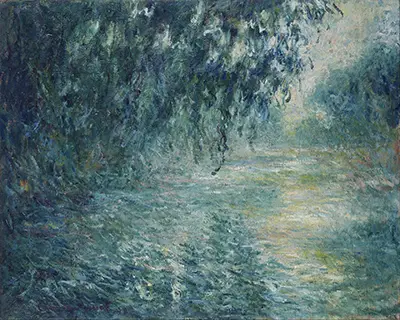Monet was famous for his pioneering Impressionist style which consisted of an application of layers of vivid colour to create a dramatic and oneiric display of light and atmosphere.
Monet particularly loved to paint objects in situ out of doors (this style of painting was known by the French term for 'out in the fresh air' or 'en plein air' at the time), and Morning on the Seine II is one key example of this painting method.
As the name of the painting makes clear, Morning on the Seine II shows us the soft tones of a misty and magical morning on the River Seine in France.
The 'II' in the painting's title indicates that Morning on the Seine II is part of a larger series of paintings and indeed this is the case - Monet painted several works that depicted the exact same spot on the Seine at different times of the day and during different seasons of the year.
Monet often painted series of oil paintings that explored the way in which the same view could look very different depending on when in the year and when in the day it was painted. Famously, for instance, he painted dozens of views of Rouen Cathedral and demonstrated just how dramatically different it looked at different times.
The particular quality of light would be different each time. Impressionists such as Monet were aided by the introduction of an easel known as the box easel, which was specifically designed for painting outdoors. This easel could be folded up to create a kind of briefcase made of wood, in which the artist's paints and other materials could be transported.
Nevertheless, having painted his works outdoors in situ, Monet would often then return with them to the studio to put the finishing touches onto them at more leisure. He may well have done this when he painted Morning on the Seine II and the other art works in the series to which this painting belongs.
The overall impression of Morning on the Seine II is one of tranquillity. The subtle effect of reflection on the water, and the warm feeling of light on the water are created by a multitude of smaller brushstrokes that have been overlaid onto broader strokes which are known as 'impasto' strokes. This layering effect is, once again, typical of Monet's very distinctive style.
The purpose of the impasto strokes was to enable Monet to capture the position and the effect of the light in the scene he was depicting. The later, smaller, strokes were designed to add in details. Sometimes he would allow the impasto strokes to dry before he added in finer brushstrokes, but at other times he would apply wet paint over wet paint for a different effect.
The vividness in Morning on the Seine II is partly also achieved by the fact that Monet did not blend his paints on a palette in the way that artists were doing a century before. Aided by the relatively recent invention of pre-mixed semi-fluid pigments in tin tubes, he would simply squeeze some paint from the tube and apply it directly to the canvas without blending it to mollify its colour. Thus, Morning on the Seine II is both soft as befits a gentle morning scene and wonderfully vivid, making a lasting impression on the viewer's mind.


